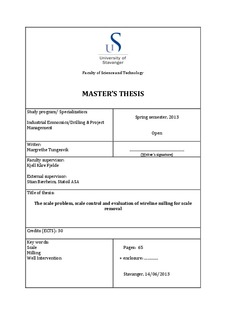| dc.description.abstract | Scale build up is one of the leading reasons for production decline in oilfields worldwide. Scale can be formed whenever water is produced; either by direct precipitation from the water that occurs naturally in the reservoir rocks, or as a result of produced water becoming oversaturated with scale components when two incompatible waters are mixed downhole. The two most common scales formed in an oilfield are calcium carbonate and barium sulfate. Scale can be found in the reservoir, along the wellbore and in the surface process system. There are various methods for controlling scale. The methods shall either prevent scale formation or remove scale that has already occurred. Scale inhibition and choosing the correct injection fluid are two methods for preventing scale formation. Removal of scale can be divided into chemical dissolution and mechanical removal. For chemical dissolution, the alternative is to bullhead the well with chemicals to remove the scale. Mechanical removal includes the use of different equipment e.g. brushes, broaches, string shots and milling.
This thesis focuses especially on mechanical wireline milling for removal of scale. Due to this, the wireline rig-up equipment for both platforms and riserless well intervention vessels, has been presented. Wireline milling is a mechanical method which uses a special tool string with a milling bit in the end, to remove scale.
Four scale milling case histories from the Smørbukk field in the Norwegian Sea has been studied. They were all performed from a riserless well intervention vessel. Different plots with measurements from one of the case histories, taken during the milling operation have been looked into. The plots contain different measurements such as head tension, current and wireline tension and are plotted against time. The objective of the thesis has been trying to locate parts of the execution of scale milling operations that can be improved. Some of the key findings were:
- When carrying out a scale milling operation; as much as possible information about the scale, and other well conditions, should be obtained before the scale milling start. This can be information about the scale type, where it is located, and the length and thickness of the scale restrictions. Other important information is temperature, pressure and fluid in the well. This information can make the choice of equipment easier and reduce the risk for something going wrong during the operation. To obtain information about the scale restrictions, a caliper can be run in well.
- The weight on bit should be controlled carefully throughout the milling operation. The correct weight on bit is crucial to avoid stalling out with the bit. The consequence of stalling with the bit is no progress in the scale milling, and maybe the need for pulling out of hole with the tool string.
- The removal of scale cuttings is very important during a milling operation. If the cuttings are not sufficiently removed, there will be an accumulation of cuttings around the mill bit and no progress in the milling.
- Real time measurement taken during the scale milling is important for having optimal control over the operation.
- In wells with challenging well conditions, like high temperature and high pressure, pre-testing of equipment for real well conditions, may be important for optimizing the scale milling operation. This can be a good measure to prevent equipment failures and short circuits during the milling operation and decrease the need for tripping in and out of hole more than planned for.
- The effect that acid has on scale is difficult to conclude based on these case histories and should be further investigated.
- The overall experience from the scale milling operations emphasizes the need for a detailed planning of milling operations. Experience, equipment limitations and the different aspects of a milling operation should be thoroughly addressed before one start to mill the scale. This may help to reduce the number of problems during the milling operation. | no_NO |
